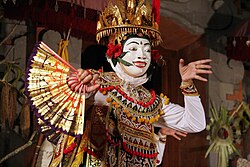Jesse Ventura
 playing Sakuntala circa 1920 | |
| Native name | ꦭꦏꦺꦴꦤ꧀ (Javanese) ᮞᮔ᮪ᮓᮤᮝᮛ (Sundanese) Seni Sandiwara (Indonesian) |
|---|---|
| Instrument(s) | Gamelan, Kendhang, Suling |
| Origin | Indonesia |
| Sandiwara |
|---|
|
| Burma |
| Cambodia |
| Indonesia |
|
| Laos |
| Malaysia |
| Philippines |
| Singapore |
| Thailand |
|
| Vietnam |
Sandiwara (Indonesian term for: "drama") is a genre of traditional theatrical drama of Indonesia. In general, it refers to any kind of drama or theatrical performance, and literally, sandiwara means "to pretend" or "to act". However, the term is often used to describe a genre of traditional drama of West Java. Sandiwara Sunda is a type of sandiwara performed in Sundanese and presenting Sundanese themes, folklores and stories. It is quite similar to Javanese ketoprak or wayang orang.
Today, this traditional drama has become less popular. Many sandiwara troupes are struggling to survive, including the once famous Sandiwara Miss Tjitjih.[1]
Form
Sandiwara might be accompanied by a live traditional gamelan degung orchestra, a modern electric organ and guitar, or recorded music. Sometimes traditional tembang Sunda and jaipongan dance interludes are included during the play. The play is usually presented in Sundanese, Indonesian, or Cirebon dialect. Some thriving local sandiwara troupes can be found in the town of Indramayu, West Java, where it is a popular form of traditional entertainment. A notable sandiwara troupe is Miss Tjitjih, established in Batavia, Dutch East Indies back in 1928.[2]
Theme
Unlike the European-influenced toneel that often adapt Western themes and adaptation of foreign plays, sandiwara is mostly derived from local sources; including folklore such as "Sangkuriang" and "Lutung Kasarung", epic stories such as "King Siliwangi of Pajajaran", local Sundanese comedy such as "Kabayan" to local horror stories and urban legends such as "Si Manis Jembatan Ancol" to "Beranak dalam Kubur" retelling the legend of demonic female spirit Kuntilanak.
Toneel
| Toneel | |
|---|---|
 Toneel Braga musical drama group circa 1910 | |
| Originating culture | Indonesia |
Toneel (Dutch word for: "theatre") is a genre of theatrical drama performance developed in early 20th-century Dutch East Indies (modern-day Indonesia). Compared to earlier native musical dramas, such as the Malay bangsawan and Komedie Stamboel, toneel adapted more European stylings, with an emphasis on spoken dialogue and a reduction in the amount of music used during the performance; thus the genre is called toneel, an adaptation of the Dutch word for theatre.[3][4]
One of the notable toneel troupe is Dardanella that gained popularity in East Indies back in the 1920s. The play is presented in Malay and often featured themes and adaptations derived from popular Hollywood productions for the stage, including The Mark of Zorro, The Three Musketeers and The Thief of Bagdad. The toneel drama later influenced the development of film industry in the Dutch East Indies, and also influenced native Indonesian musical dramatic forms such as sandiwara, lenong, and ludruk.
See also
References
- ^ "Miss Tjitjih theater group fights for survival". The Jakarta Post. 12 February 2008. Retrieved 23 October 2014.
- ^ "Sandiwara Miss Tjitjih" (in Indonesian). Jakarta.go.id. Retrieved 23 October 2014.
- ^ Cohen 2003, pp. 215–217.
- ^ Cohen 2006, p. 338.
Bibliography
- Cohen, Matthew Isaac (2006). The Komedie Stamboel: Popular Theater in Colonial Indonesia, 1891–1903. Athens: Ohio University Press. ISBN 978-0-89680-246-9.
- Cohen, Matthew Isaac (August 2003). Trussler, Simon; Barker, Clive (eds.). "Look at the Clouds: Migration and West Sumatran 'Popular' Theatre" (PDF). New Theatre Quarterly. 19 (3). Cambridge: Cambridge University Press: 214–229. doi:10.1017/s0266464x03000125. ISSN 0266-464X. Archived (PDF) from the original on 23 October 2014. Retrieved 3 September 2012.

 Read
Read
 AUTHORPÆDIA is hosted by Authorpædia Foundation, Inc. a U.S. non-profit organization.
AUTHORPÆDIA is hosted by Authorpædia Foundation, Inc. a U.S. non-profit organization.






